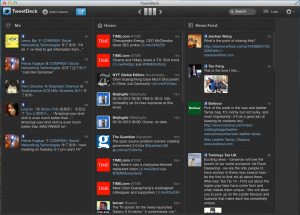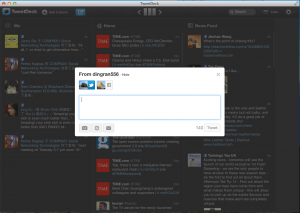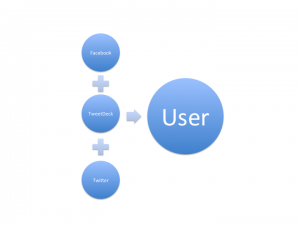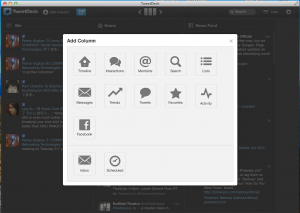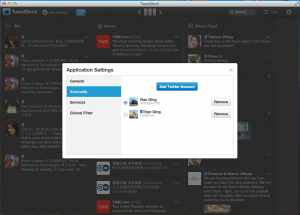Archive for May 3rd, 2012
Research Case: TweetDeck
Posted by dingran in Research Case on May 3, 2012
1. Background Introduction
The original TweetDeck is an application developed by Iain Dodsworth, A British programmer from 2009 to 2011. In previous editions, it allows user access multiple accounts from Facebook, Twitter, LinkedIn, Google Buzz and MySpace by different columns. It was the most popular Twitter application with Market share 23% on June 2009 [1]. After a potential threat happened that another company showed a strong interest on TweetDeck and willing to offer $25-$30 million to buy TweetDeck, Twitter purchased TweetDeck possible in double price finally [2]. After this acquisition, TweetDeck changed from an Adobe AIR programme into OS native applications. However, after TweetDeck became a part of Twitter, some features of TweetDeck were removed such as Tweet more than 140 words. [3]
2. Features of TweetDeck
After download and installed TweetDeck, user first needs to register a TweetDeck account.
Because all update information is send through TweetDeck, so user also needs to give TweetDeck authority from relevant social networks.
After all were set down, user will first see the main page of TweetDeck, it is consisted of three columns while user can shift those columns to left and right.
Each column could display things like twitter home, Facebook @me, Facebook News feed, or favorite tweet etc. When user wants to post or update something to Twitter or Facebook, a pop-window will be displayed and user can choose options of social networks where the information should go.
There are following features supported by TweetDeck:
1. Post tweet and statement in text to both Facebook and Twitter at once.
2. View the information from Twitter (Trends, Titter Home, Lists, Mentioned and Message) and Facebook (Newsfeed and Notification).
3. User can define the interface by adding or removing column from the interface. Each column presents the content from Twitter or Facebook.
4. User could have multiple Twitter accounts online at same time.
3. Advantages of TweetDeck
l Universal:Although today people usually have several accounts on different social networks, there are few universal clients for such need. TweetDeck earned such high market share owe to it integrated other social networks, which save a lot of time for user to manage accounts. To social networks, especially for twitter, since information on Twitter is frequently updated, if user could easily share information from Twitter to other social networks, then it would help user stay with Twitter longer, and it also increases the frequency/chance that a user visit other social network.
l General Access: The original TweetDeck is developed under Adobe Air, so user just needs to log in it as Web Application without OS problems. After purchased by Twitter, TweetDeck also provides OS native application and mobile edition on iOS and Android system.
l Easy to manage: TweetDeck gives user a straightforward way to view tweet and information from Facebook. By switching to different columns, user can easily browse different catalogues of information. To send a new tweet or statement, user just need to click the button on top left and select relevant social network.
4. Disadvantages of TweetDeck
l Network Barriers: One of the most difficult challenges for an universal client is that different social networks would apply various APIs for third party to transmit data. For instance, Twitter regulated a picture should be expressed as a ‘short link’ in a tweet, however, on Facebook it should be directly uploaded to Facebook with statement. When user wants to share a picture to both Twitter and Facebook through TweetDeck, it usually causes a problem as update failure. And due to different structure between Twitter and Facebook (information flow-based and person-based), TweetDeck offered more options of viewing for Twitter than Facebook.
l Monopoly: After Twitter purchased TweetDeck. TweetDeck began to incline to twitter contents. Some attractive features including deck.ly, a feature allows user send tweet more than 140 words, were removed by Twitter. Meanwhile, TweetDeck gives more options on Twitter information than other social network. Compared with Twitter, there are only two information flows are provided to user: News Feed and Notification.
What’s more, a user is able to add multiple accounts on Twitter but only one account on Facebook.
Those leads user believe that TweetDeck is no longer a universal client but a Twitter client now.
l Function Limit: Because each social network has its unique functions, a universal may not be able to present them all in common panel and interface. In TweetDeck, it supports most operations on Twitter while a lot of operations to Facebook are accomplished by redirecting to Facebook webpage. By our interview, some users also stated that they would like to use a specific client rather than a universal client to fully enjoy a social network.
5. Summary
TweetDeck is a very good example about how a universal client achieved success from social network users. Even though the application started as an individual developed programme without any profit, it finally attracted Twitter’s attention and earned both cash and stock from Twitter Company to its developer. However, such deal sacrificed the further improving space for TweetDeck. And we should find some other profit point to keep our application having a good future.
Reference:
1. An In-Depth Look Inside the Twitter World, http://www.sysomos.com/insidetwitter/
2. Twitter confirms TweetDeck acquisition http://www.guardian.co.uk/technology/2011/may/25/twitter-confirms-tweetdeck-acquisition?INTCMP=SRCH
3. TweetDeck kills off Deck.ly’s long-form integration with an all-platforms update http://thenextweb.com/apps/2011/09/15/tweetdeck-kills-off-deck-lys-long-form-integration-with-an-all-platforms-update/


